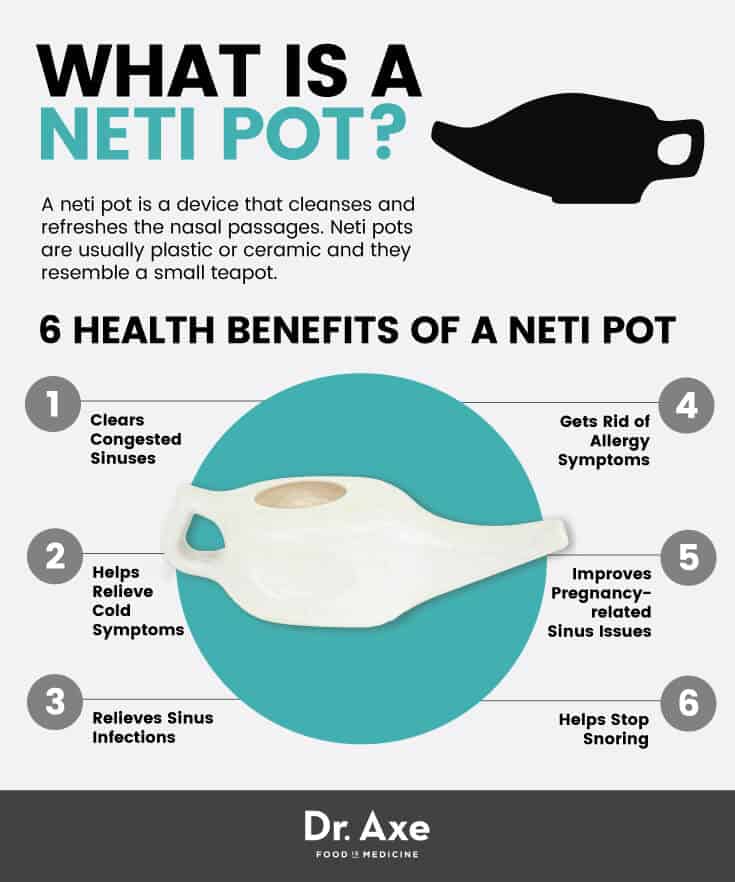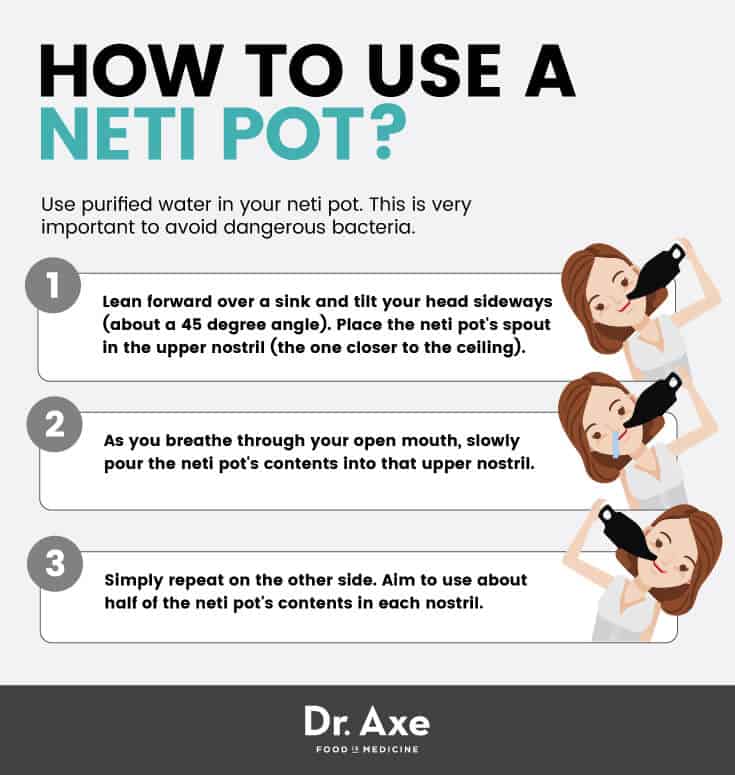
A neti pot is used for nasal irrigation. Nasal irrigation? It may sound strange, but it’s simply the act of flushing out your nasal cavity. A neti pot allows a user to do just that quickly and efficiently with a solution of purified water and salt. Yes, that’s right — just two simple ingredients. If there is any mucus or allergens clogging up and irritating your nose then a neti pot may be just what the doctor ordered. In fact, many doctors recommend using a neti pot for general nasal congestion as well as colds, allergies and sinus infections.
According to one study of 330 actively practicing family physicians, 87 percent recommended saline nasal irrigation (which is what you do with a neti pot) as part of their treatment recommendations for the following health issues: chronic sinus infections (91 percent), acute bacterial sinus infections (67 percent), rhinitis (stuffy nose) resulting from seasonal allergies (66 percent), viral upper respiratory infections (59 percent), other allergic rhinitis (48 percent), irritant-based congestion (48 percent), and rhinitis due to pregnancy (17 percent). (1)
In addition to breathing easier through their noses, many neti pot users also report a better sense of smell and taste after a neti pot session. (2) According to doctors at the FDA, neti pots are typically safe as long as they are used and cleaned in the proper manner. (3) These days, you can easily find a neti pot at your local drug store or health food store without breaking the bank (it’s easy to find good ones for around $10). After you read this article, you may just want to go pick one up if you don’t own one already. I’ll also tell you just how easy and down right cheap it is to make your own neti pot solution at home.
What Is a Neti Pot?
A neti pot is a device that cleanses and refreshes the nasal passages. Neti pots are usually plastic or ceramic and they resemble a small teapot. The neti pot has its origin in Ayurvedic medicine. “Neti” is actually Sanskrit for “nasal cleansing.”
How do neti pots work? By design, a neti pot enables its user to pour a nasal rinse into the nostrils in such a way that it flushes out irritants and thins out mucus. This typically leads to less congestion and easier breathing through the nose. A neti pot acts as somewhat of a booster for your body’s own natural operations. What do I mean by that? Microscopic, hair-like structures called cilia line your nasal cavity and the surrounding sinuses. Cilia help to usher mucus out of your nose. Nasal irrigation with a saline solution is said to help the cilia work better at getting rid of mucus and unwanted particles (like dust, pollen, etc.) that often lead to sinus issues. (4)
A neti pot is filled with purified water and salt or salt-based mixture specifically designed for neti pot use. It’s also super easy to create your own homemade neti pot solution (recipe coming later in this article). You may be wondering why you can’t use water by itself in your neti pot. The interesting fact is that using water alone can actually irritate the inside of your nostrils. Adding salt to purified water permits the water to travel through the sensitive membranes of the nasal passages with very little to no burning sensations. (5)

6 Health Benefits of a Neti Pot
1. Congested Sinuses
In India, flushing warm salty water through the nasal cavities has been used for centuries to help with nasal congestion as well as allergies. Sometimes we can experience sinus congestion due to environmental irritants including dust, pollen, chemicals, or synthetic fragrances. In general, a neti pot is an excellent tool to perform nasal irrigation and reduce general sinus congestion. Whatever the cause, neti pots are best known to help get the inside of your nose in a healthier, less irritated state by flushing out any unwanted invaders and excess mucus. (6)
2. Colds
One of the most classic unwanted symptoms of the common cold is nasal congestion. It can also be accompanied by sinus headache and facial pain. When you use a neti pot for a stuffy nose due to a cold, you can thin out the mucus so it can drain out more easily. This can help to relieve multiple cold symptoms. In addition to using a neti pot, you should also drink a lot of water to help break up mucus. (7)
3. Sinus Infections
Not only can using a neti pot help with an acute sinus infection, it can even provide relief for chronic sinusitis. A study published in the Canadian Medical Association Journal revealed that patients suffering from chronic sinus infections were able to improve their symptoms and maintain positive outcomes for six months. The study subjects not only got relief from sinus congestion. They also experienced fewer headaches and resorted to over-the-counter medicines a lot less. Dr. Richard J. Harvey, a professor of rhinology at Macquarie University, also points out that higher volume neti pots definitely trump nasal sprays. This is because the neti pot actually accomplishes true nasal irrigation removing irritants as well as excess mucus. (8,9)
4. Allergies
If you’re one of the millions of people that suffer with allergies on a yearly basis, when your season comes around it’s a good idea to get out your neti pot. Seasonal allergy symptoms commonly include nasal congestion and post-nasal drip. According to Melissa Pynnonen, M.D., co-director of the Michigan Sinus Center, “One of the best methods for relieving the symptoms is nasal irrigation. It’s like a power washer for your nose.” Nasal irrigation with a neti pot is even said to work better than medications for common sinus issues. Many doctors, like Dr. Pynnonen, consider it “a first-line treatment for common nasal and sinus symptoms.” (10)
A 2010 scientific review published in the American Journal of Rhinology and Allergy also confirms that nasal irrigation with a saline solution is not only a safe and inexpensive way to improve a stuffy nose caused by allergies. It also improves overall quality of life for the allergy sufferer and leads to less of a need for allergy medications. (11)
5. Pregnancy-related Sinus Issues
For some women, pregnancy brings on much more than food cravings and fatigue. Thanks to hormonal chances, some pregnant women also commonly experience nasal congestion. Pregnancy experts like the American Pregnancy Association and the Mayo Clinic commonly recommend nasal irrigation as a safe and effective home remedy to improve general congestion as well as congestion due to sinus infections and allergies for moms-to-be. (12. 13)
6. Snoring
If sinus congestion causes your snoring, then guess what — a neti pot can help to unclog your nose. Once you get rid of the congestion, you are likely to get rid of your unwanted snoring habit. A neti pot may be just the ticket to a snore-free sleep for some. (14)
How to Use Correctly + Homemade Neti Pot Solution
It’s absolutely essential that you use a recommended and safe water source in your neti pot. According to the FDA, these are the only acceptable water options for a neti pot: (15)
- Distilled or sterile water (the label will indicate “distilled” or “sterile”), which you can purchase in stores.
- Tap water that boiled for at least three to five minutes and then allowed to cool so that it’s lukewarm before use.
- Previously boiled water stored in a clean, closed container for up to 24 hours.
- Water that has gone through a filter specifically designed to trap potentially infectious organisms. CDC filter recommendations include one that has an absolute pore size of 1 micron or smaller or a label that reads “NSF 53” or “NSF 58.”
When it comes to the solution, you can buy a pre-made sinus rinse. Or, you can make your own homemade neti pot solution. Simply combine one cup of purified (see list above) water with a quarter teaspoon to a half teaspoon of non-iodized salt. You can also include a pinch of baking soda if you would like. If you use two cups of water then double the amount of salt and baking soda. (16)
It is vital that you don’t use a salt in your neti pot that contains any additional ingredients. You only want one ingredient in the salt that you use to make a homemade neti pot solution: salt. A healthy solution is said to mimic the salt-to-water balance of your body’s own tissues. You can use sea salt, kosher salt or a plain cooking salt for your solution. (17)
READ RELATED: Let’s Debunk Some Of The Age-Old Myths About Diabetes
Once you have your nasal rinse solution in your neti pot and your hands washed and dried, you are ready to use your neti pot.
How to use a neti pot: (18)
1. Lean forward over a sink and tilt your head sideways (about a 45 degree angle). Place the neti pot’s spout in the upper nostril (the one closer to the ceiling)
2. As you breathe through your open mouth, slowly pour the neti pot’s contents into that upper nostril. You will immediately see the neti pot solution begin to come out of the lower nostril. This is a good thing — the nasal irrigation has officially begun!
3. Simply repeat on the other side. Aim to use about half of the neti pot’s contents in each nostril.
The whole process doesn’t take more than around 5 minutes so it’s not a big time obligation. In terms of messiness, you definitely want to be leaning over a sink because you will have liquid coming out of your nostrils. After some practice, you probably won’t get your clothes wet. In the beginning, you may have a few water spots after you’re done. Don’t worry, they’ll dry quickly and won’t stain.

Common Mistakes & Risks with the Neti Pot
The number one risk when it comes to neti pots is using a dangerous water source. By dangerous, I mean water that contains bacteria. This can happen if you use tap water in your neti pot that has not been boiled and cooled first. ALWAYS use recommended water sources and don’t take any chances whatsoever. A neti pot death can occur if you use water infected with deadly bacteria. In 2011, there were at least two deaths in the United States due to improper neti pot use. Both deaths were the result of using tap water contaminated with Naegleria fowleri, a very fatal type of bacteria. (19)
Naegleria fowleri causes the brain infection known as primary amebic meningoencephalitis (PAM). Symptoms of PAM usually begin 1 to 9 days after infection. At first symptoms can include headache, fever, nausea, or vomiting. Later stage symptoms may include stiff neck, confusion, lack of attention to people and surroundings, loss of balance, seizures and hallucinations. The disease tends to rapidly get worse and typically leads to death within about 5 days of onset. (20) Not to freak you out, but there truly is a very good and scary reason why you don’t want to mess around with the water you use in your neti pot.
In addition to using purified water, it is absolutely essential that you keep your neti pot extremely clean. Every single time you use it, clean it thoroughly with the same high quality of water that you used in it to prevent any bacteria. It is also important to allow your neti pot to air dry completely between uses or you can dry it well with paper towels. If your neti pot is dishwasher-safe then you can put it through the dish washer every so often. Make sure to wash and dry your hands before using your neti pot to remove any germs. (21)
Neti pots are like toothbrushes and they should never be shared. Of course, it would be more cost effective to share a neti pot with your family members. But, it is not the safe or sanitary thing to do.
Another common mistake with neti pots is to over-use them. As with many natural remedies, overdoing it does not lead to better results, but can actually cause more problems. A 2009 study found that a short-term practice of nasal irrigation can be helpful and therapeutic, but long-term use can actually be harmful. It’s theorized that using a neti pot too routinely may remove some of the essential protective elements of the mucus membranes that line the nasal passages and sinuses. (22) That is definitely not what you want, so make sure not to over-use your neti pot.
Neti pots are not recommend for infants. (23) If you experience any discomfort or unwanted side effects after using a neti pot, discontinue use and seek medical attention.
Final Thoughts
It’s pretty awesome that a little teapot-like vessel and some salty water can offer such easy and fast relief for nasal congestion. Using a neti pot is not hard to do and it’s not expensive. It’s not even meant to be done too often.
When used appropriately, even the conventional medicine world agrees with holistic and Ayurvedic medicine practitioners. Neti pots are awesome at relieving nasal congestion for all kinds of reasons including allergies, the common cold, sinus infections and pregnancy. The scientific studies are also there to back up this century-old nasal irrigation tool. Just remember to use the right kind of salt (no additives!) with a safe, purified water in a properly cleaned neti pot.
If you have nasal congestion, get your neti pot out. In under five minutes, you are likely to be breathing a lot (or at least a little) easier!
Read Next: Top 5 Essential Oils for Allergies
Source: Dr. Axe






